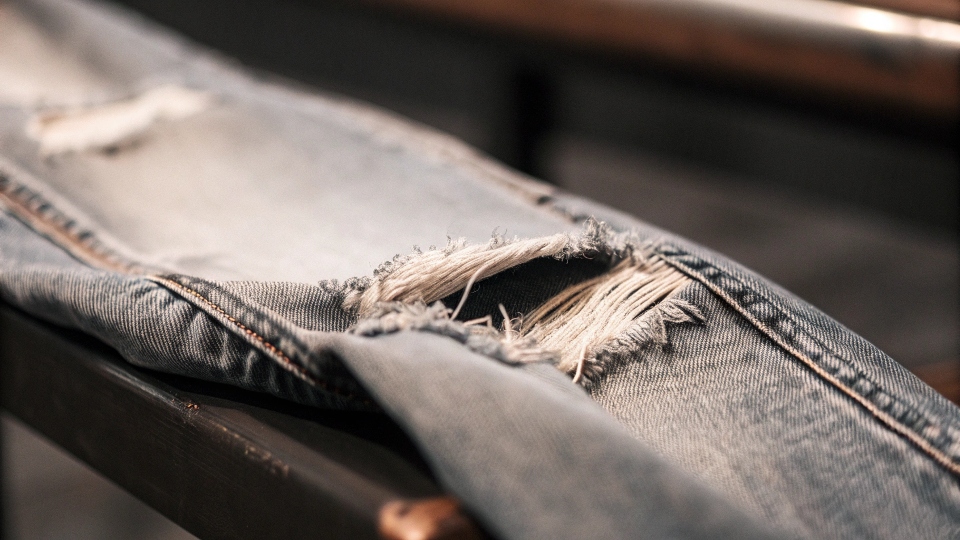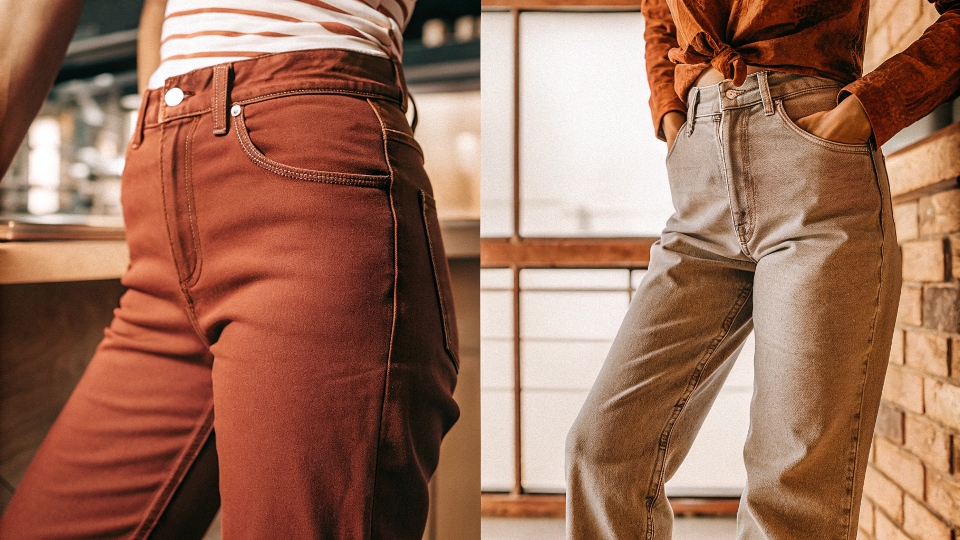You found the perfect pair of jeans, but a few months later, a hole appears in the thigh. It's frustrating and expensive to constantly replace your favorite wardrobe staple.
Your jeans wear out quickly1 due to friction2, fabric choice, and washing habits3. Constant rubbing in high-stress areas4 like the crotch and inner thighs, combined with the weakening effect of frequent, harsh washing, causes the denim fibers to break down and tear over time.
This is a problem I've looked at from every angle during my 20 years running the DiZNEW denim factory. Jeans are built from cotton, a natural fiber designed to age, fade, and eventually break down.
This aging process is part of their character. My designer friend Dean even says that a jean's life story is written in its wear patterns5. But sometimes that story ends too soon.
The speed at which they wear out isn't an accident; it's a direct result of the materials, how you use them, and the hidden power of your washing machine.
Why are my jeans wearing out so fast?
You wear your favorite jeans, and without fail, holes appear in the same spots. You start to wonder if they are just poorly made or if you're doing something wrong.
The main reason is intense, repetitive friction2 in specific areas. Your inner thighs rubbing together as you walk is the number one cause. The type of fabric also matters; lightweight stretch denim6 often wears out faster than heavy, 100% cotton denim7.
In the denim industry, we call these "high-stress points." The crotch and inner thighs are the biggest culprits. Every single step you take creates a small amount of rubbing.
Over thousands of steps a day, this friction acts like fine-grit sandpaper, slowly wearing away the cotton fibers until they become thin and eventually snap. Another high-stress point is the back pocket, especially if you carry a thick wallet. The constant pressure and movement will wear a perfect outline into the seat. The fabric itself plays a huge role.
Many modern jeans are made with elastane (spandex) for comfort and stretch. While this feels great, those elastic fibers are not as strong as cotton. They can break down first, leaving the cotton structure weak and more susceptible to tearing.
A heavy, rigid, 100% cotton jean simply has more raw fiber and structural integrity to withstand this daily friction for a longer period.
Key Factors in Rapid Jean Wear
| Factor | How It Causes Wear | Common Area Affected |
|---|---|---|
| Friction | Constant rubbing from walking, sitting, and moving breaks down cotton fibers. | Inner thighs, crotch, back pockets (from wallets). |
| Fabric Type | Stretch fabrics contain weaker elastane fibers that fail before cotton does. | Thighs and seat area, where stretch is most engaged. |
| Fabric Weight | Lighter "fast fashion" denim has less material, so it thins out and tears faster. | All over the garment, but holes appear first at stress points. |
How long should a pair of jeans last?
You buy a new pair of jeans, and you're not sure what to expect. Should they last one year or ten? The uncertainty makes it hard to know if you're getting good value.
The lifespan a pair of jeans depends entirely on its quality, how often you wear it, and how you care for it. A high-quality pair worn once a week could last 5-10 years. A cheap, thin pair worn daily may only last a year.
There is no single answer to this question, but we can look at the variables. The most important factor is the denim itself. At my factory, we work with denim ranging from a flimsy 9-ounce weight to a rock-solid 16-ounce weight.
A heavier, 100% cotton selvedge denim is built like a tank and is designed to last for years, even a decade, with proper care. A lightweight, 9-ounce stretch denim made for a fast-fashion brand is designed for immediate comfort and a low price point, not longevity.
You can't expect a product engineered for a single season to perform like one built for a lifetime. Your lifestyle is the next biggest factor. If you have a desk job and rotate between five pairs of jeans, they will last much longer than if you have one pair that you wear every day for a physically demanding job.
A good rule of thumb is that if you are paying under $50 for a pair of jeans, a year of regular wear is a reasonable expectation. If you are investing over $150, you should expect to get several years of life out of them.
How can I make my jeans last longer?
You love your jeans and want to keep them from falling apart. Throwing them out seems wasteful, and you're looking for simple ways to extend their life and save money.
The most effective way is to change your laundry routine. Wash them less often. When you do, turn them inside out, wash in cold water, and always hang them to dry. The high heat of a machine dryer is the biggest enemy of denim.
The secret to a long life for your jeans is gentle care. Washing machines and dryers are incredibly harsh environments. All that tumbling creates friction, and the heat fundamentally damages the fibers.
Turning your jeans inside-out before washing protects the outer surface from abrasion and helps preserve the color. Using cold water is crucial because hot water can cause the cotton fibers to shrink and become brittle. Most importantly, avoid the machine dryer completely. The intense heat literally cooks the cotton, making it weak.
For stretch jeans, it's even worse; the heat melts and degrades the delicate elastane fibers, which is why stretch jeans lose their shape and recovery over time. A simple hang-dry or flat-dry preserves the integrity of the fabric. Another tip is to rotate your jeans.
Don't wear the same pair every single day. Giving the fibers a day or two to rest and relax helps them last longer. Finally, learn to love small repairs. A small tear can be patched from the inside before it becomes a massive hole.
Why don't jeans last as long anymore?
You remember jeans from your youth being incredibly tough and durable. Today, it feels like they fall apart if you look at them the wrong way, and you wonder why quality has declined.
The market has shifted to prioritize immediate comfort and low prices over long-term durability. "Fast fashion" and the popularity of soft, stretchy denim means many jeans are now made from lighter, less-robust materials by design.
As a manufacturer, I have seen this shift firsthand. Twenty years ago, the benchmark for quality was toughness. Today, for many brands, the benchmark is softness on the shelf and a low price tag.
This change is driven by two main forces. First is the demand for comfort. Consumers now expect their jeans to feel like sweatpants from the very first wear. This requires using lightweight denim with a high percentage of stretch, which, as we've discussed, is inherently less durable than old-school rigid denim.
The second force is fast fashion. To keep prices incredibly low, these companies must use thinner materials and less expensive construction methods. They might use a lower stitch count per inch or a weaker thread, all of which shaves off costs but also reduces the garment's lifespan.
Furthermore, many modern styles are sold "pre-distressed." The chemical washes and physical abrasion we use in the factory to create those fashionable worn-in looks are literally destroying parts of the fabric before you even buy it. A heavily distressed pair of jeans has a much shorter remaining life by its very nature.
Conclusion
Jeans wear out from friction and washing. Their lifespan is determined by the fabric quality you choose, your wear patterns, and a gentle care routine that avoids the machine dryer.
-
Understanding the reasons behind rapid wear can help you choose better jeans and extend their lifespan. ↩
-
Learn how friction impacts the durability of your jeans and what you can do to minimize it. ↩ ↩
-
Discover how your laundry routine can significantly impact the longevity of your favorite jeans. ↩
-
Identifying high-stress areas can help you understand where your jeans are most likely to wear out. ↩
-
Learn how your unique wear patterns can influence the lifespan of your jeans. ↩
-
Find out why lightweight stretch denim may not be the best choice for longevity. ↩
-
Learn about the benefits of 100% cotton denim and why it lasts longer than blends. ↩










